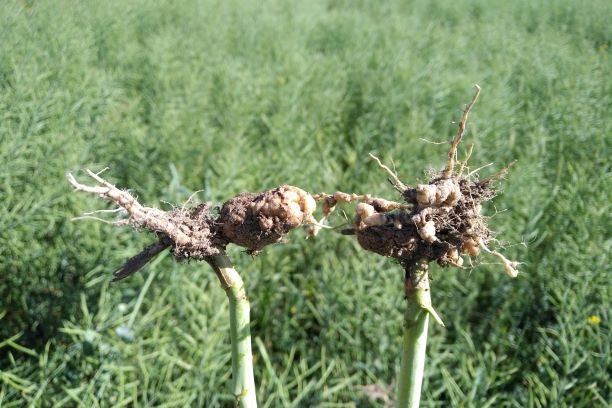In the summer of 2020, 10 of the 13 rural Peace Region (PR) municipalities participated in a soil-sampling project partially funded through the Canadian Agricultural Partnership (CAP) Agreement. The project was to randomly sample 2 fields in each agricultural township in the Peace. Unfortunately, the other 3 of the 13 PR municipalities were unable to participate.
Detailed reports of the work done in each of the ten participating municipalities are available from your local AF. The following is a summary.
Inspectors surveyed five hundred sixty-five fields in two hundred, eighty-nine and one-half agricultural townships. Six fields of those surveyed were positive or had “detected” clubroot in the soil samples in four municipalities. Two municipalities had two positive fields, and two had one field each. Quantitative analysis of the soil samples revealed the following numbers of resting spores per gram of soil:
- Big Lakes County had two fields with levels of 2500 and 6700
- County of Grande Prairie had one field with 2.2 M and one test result pending
- M.D. of Greenview had one field with 6,000
- One field in Birch Hills County returned a test result of <1,000. The lab revisited this sample and produced a “not detected” response. This suspicious field was considered positive for clubroot based on the first soil sample test result.
The other six municipalities had zero detections for Clubroot through the soil samples. Looking purely at the number of clubroot infestations discovered with the soil sampling project, the ten municipalities in the Peace (and by extrapolation, the entire Peace Region) would have an infection level of just over 1% (6 fields in 565 surveyed). However, additional clubroot surveillance revealed that soil sampling did not sufficiently tell the Peace Region clubroot story.
While gathering soil for analysis through the CAP project, eight of the ten municipalities also pulled and visually checked canola plants. The four municipalities with detected clubroot in soil samples were all represented in the eight that pulled and checked canola plants. Inspectors visually inspected the roots in five hundred and seventeen fields.
M.D. of Spirit River, Saddle Hills County & Clear Hills County inspectors checked roots while collecting soil samples and did not identify any clubroot symptoms.
In the M.D. of Greenview, the sole soil sample which returned a “detected” result was on a field that had been positively identified with clubroot symptoms when it was in canola in 2019.
In the M.D. of Smoky River, the soil of sixty-four fields sampled (with 0 detected clubroot) had four plant samples considered suspicious for clubroot. Three of these tested positive for clubroot. The inspectors collected more soil samples from the suspicious patches where the three positive plant samples were collected. Only one returned a positive lab test for clubroot with a reported level of 18,000 spores/gram. One field returned a “not detected” in the patch sample. The original sample collected under the CAP project was, without question, infested with clubroot, and roots showed severe galling. Inspectors collected another sample from an infested patch, split it in two, and sent each sample to a different lab for analysis. One lab returned a “not detected” while the other produced a “detected” with spore levels over 6,000,000.
In Birch Hills County (BHC), of the fifty-four fields sampled, one had clubroot detected in the soil sample. In comparison, visual inspections of canola plants detected three fields with clubroot. Still, all three produced lab-tested soil results for clubroot of “not detected”. The one area with the detected result in the soil sample was re-sampled following the CAP protocol and using GPS coordinates to sample from the same sites. The second sample returned a “detected” result, and the quantification came back as <1,000. When BHC questioned the lab on this quantification result, the lab changed the result to “not-detected”. For the purposes of this project, the field was reported as having clubroot detected through soil sampling.
In Big Lakes County, two fields of the seventy randomly checked had clubroot detected in the soil; one had low levels identified in the plants; the other showed no visible symptoms in 2019 when canola was last grown on this field. Inspectors also checked known clubroot-infested fields (more on this later).
In three municipalities, where plants were visually inspected, and soil samples were collected simultaneously, seven plant samples returned a “detected” result. This result is a slightly higher detected ratio in the plants vs soil at 1.35% (7/517 samples).
However, if comparing the two municipalities which detected the most clubroot-positive fields in 2020, M.D. of Smoky River had a 0% detection in the soil samples and 4.6% detection in the plant samples (3/64). Birch Hills County had a 1.8% detection level in the soil (1/54) and 5.5% detection in the plants (3/54).
In the County of Grande Prairie and Birch Hills County, where three soil samples returned a detected result with no visual plant symptoms, at least two of the fields were sown to a Clubroot resistant (CR) variety. Seeding with a CR variety may account for the positive result in the soil sample, but a lack of plant symptoms.
Further work that is outside the scope of the project but relevant;
In Birch Hills County, inspectors surveyed 24 more fields following the Alberta Blackleg and Clubroot survey protocol. Clubroot was identified in five of these fields. One of the five fields was soil sampled in suspected clubroot patches, and the lab test confirmed clubroot was “detected”.
Big Lakes County (BLC) inspectors collected and submitted a further sixteen samples using the CAP protocol. Fifteen of the sixteen samples were obtained from eleven fields with known clubroot infestations and one sample from a field with a suspected infestation. Nine samples (from five fields) returned clubroot “detected” results. Three of the five fields were sampled more than once. While the repetitive sampling is acknowledged, the results are thought-provoking. In each instance, inspectors followed the project sampling protocol. BLC discovered Clubroot in these three fields where multiple sampling occurred in 2017, and at that time, all were rated identically regarding plant infections (55 at 0, 5 at 1). Quantitative analysis revealed the following highly variable spore levels,
- field 1 had results of 4,800 and 13,300 sp/gr,
- field 2 had results of 8,200 and 16,800 sp/gr,
- field 3 had results of 61,900, 3,400 and 2,000 sp/gr.
Inspectors sampled the remaining nine fields with known clubroot infestations using the CAP protocol. Of these nine fields, only two returned a “detected” result for clubroot from the soil samples.
The BLC soil sampling results on known clubroot-infested fields sheds a very dim light on soil sampling as an accurate means to discover clubroot. Soil sampling detected clubroot only five times in eleven known infested fields (45%). This poor correlation indicates further research and improvement is needed to fine-tune soil sampling and test procedures so that it is a reliable means of confirming the presence of symptomatic levels of the clubroot pathogen in soils. Based on the results from this project, visual inspections of host roots appears to be a superior method for inspecting fields for the presence of clubroot. It allowed detections twice as often as soil analysis and was significantly faster and less expensive. Sometimes plants are sent to a lab for confirmation which adds cost and time to the identification of clubroot. The only drawback to visual inspections was that it was limited to fields with a host crop (canola), while the soil sampling could be done in any field regardless of the crop type.
Quantification results (resting spores per gram of soil) were extremely inconsistent between samples and when correlated to visual symptoms. For example, when Big Lakes County inspectors collected soil samples three times in approximately the same spots in the fields the results were 61,900/g, 3,400/g, & 2,000/g. In Smoky River, when a known patch was re-sampled (first time it returned a not-detected result), and even when analyzing the same soil sample split into two bags, the two labs produced results that varied by six orders of magnitude, from “not-detected”, to detected with a spore load greater than 6 million. The results of this work appear to indicate that galling of susceptible plant roots is a more reliable and accurate indicator of the presence of the clubroot pathogen than soil sampling. However, as CR varieties become more widely deployed, finding galls may become more difficult.
From this CAP project, the PR extrapolate that research work or data that uses soil sampling to identify the presence or absence of clubroot may also be subject to a similar lack of consistency and accuracy, bringing these results into question. We also believe the same for research and data that uses soil sampling to indicate spore levels increases or decreases.
Normand Boulet, CCA, Agricultural Fieldman (AF), M.D. of Smoky River
asb@mdsmokyriver.com

